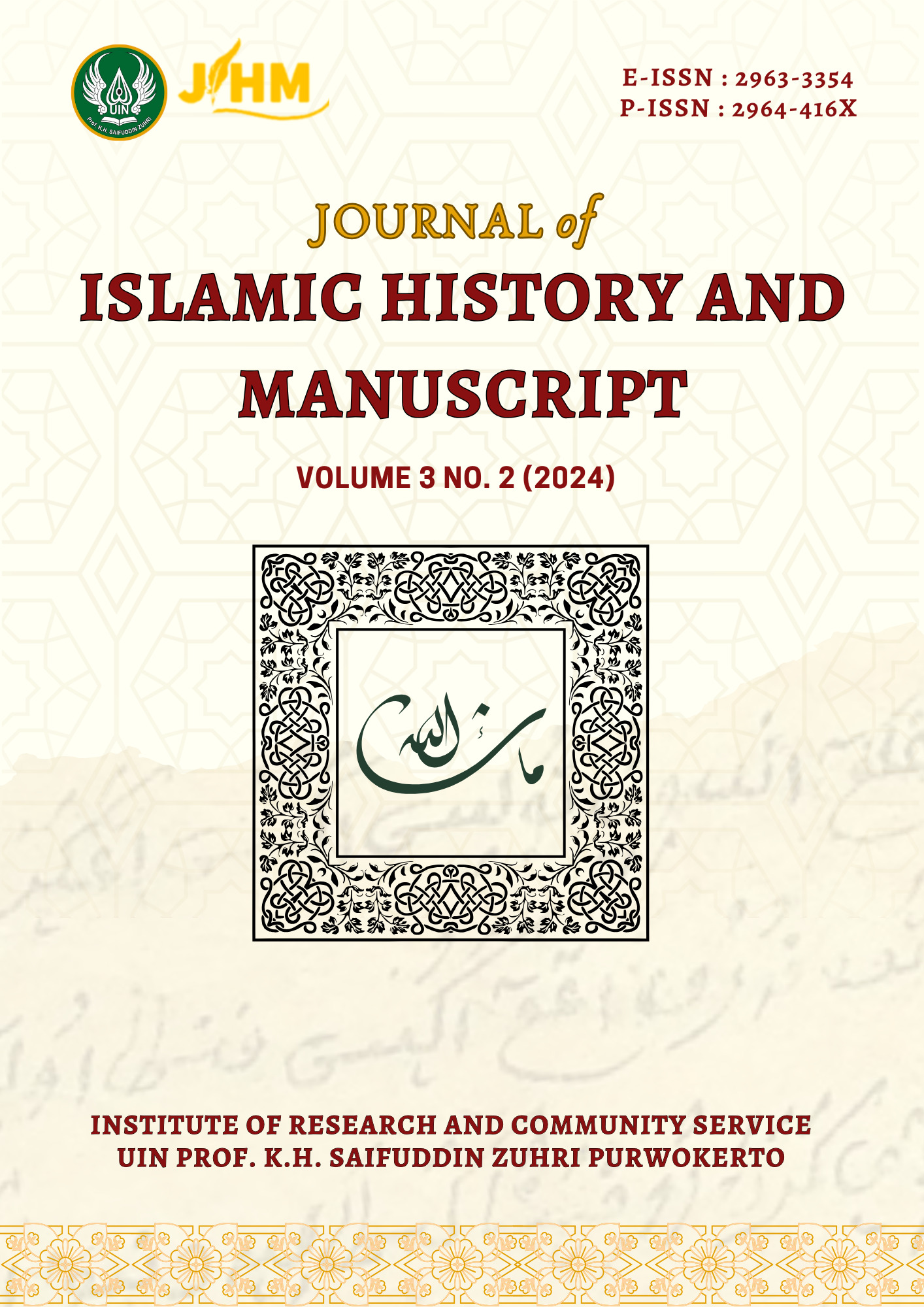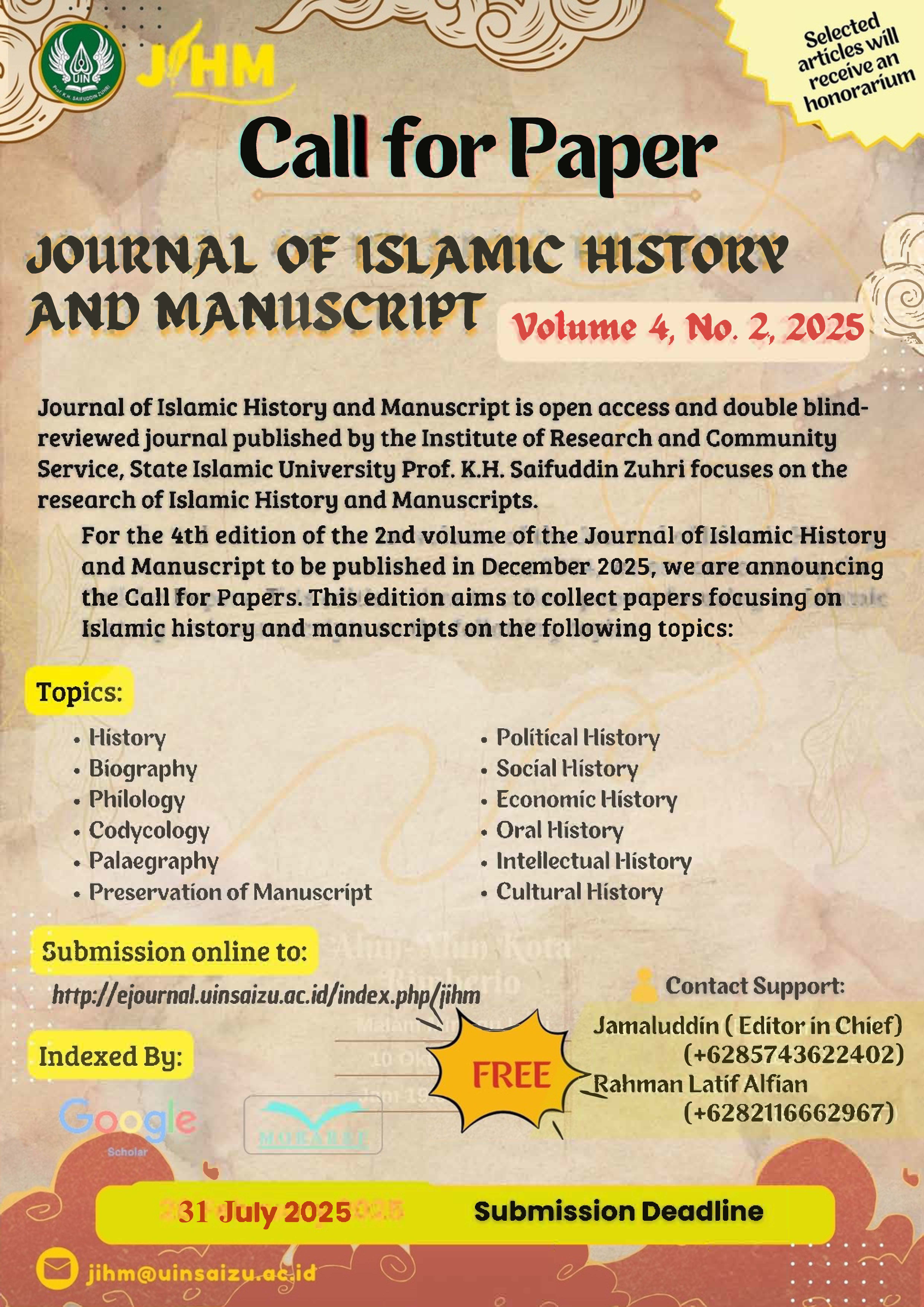Preliminary Survey Results From a Medieval Islamic Settlement Site in Eastern Ethiopia: First Archaeological Insight from Fedis
DOI:
https://doi.org/10.24090/jihm.v3i2.9714Kata Kunci:
East Africa, Eastern Ethiopia, Islamic archaeology, medieval Islamic sites, FedisAbstrak
Islam in Ethiopia has a profound impact as one of the streams of its long history. It has been present in the country for almost one and a half millennia. It was first introduced to Axum in northern Ethiopia in AD 615, also referred to as the ‘first hijra’, followed by the subsequent expansions to Shoa in central and eastern Ethiopia through Dahlak and Zeila ports since the 9th century AD. The main agents of these expansions were caravan traders and refugees. Coinciding with such intensified trade and the Islamisation process, eastern Africa witnessed the emergence and consolidation of several Muslim principalities, including in modern-day Ethiopia, from the 11th century AD onwards. Fedis, as one of those principalities within modern-day Ethiopia, was mentioned in Amde Seyon’s chronicle in the 14th century AD. However, Islamic history and archaeology in Ethiopia remain understudied until recently. As part of this negligence, Fedis site has never been studied until the completion of this research. Inspired by its historical mentions and an old map revealing several ruins of settlement sites south of Harar, the researchers conducted a preliminary survey of this particular site in 2021 and 2022. Accordingly, various remains were identified from Fedis that confirmed the site’s archaeological potential. During the fieldwork, ruins of an elaborate stone-built defensive wall, a succession of mosques, a stepwell, carnelian-made seal carved with Arabic text, beads of various kinds, storage pits of different sizes and burials were the findings explored, among many others. As confirmed from these findings, this pilot research sheds new and first archaeological insight into the medieval Islamic site of Fedis in eastern Ethiopia.Referensi
Ayantu, M. (2016). Mapping Historical Traces: Methogensis, Identity and Representation of the Harela: A Historical and Anthropological Inquiry.
Braukamper, U. (2022). Islamic History and Culture in Southern Ethiopia: Collected Essays. LIT Verlag Münster.
Breton, J.-F., & Ayele, Y. A. (2019). Kwiha (Tigray, Ethiopia): The Aksumite city. Afrique : Archeologie et Arts, 15, 53–66. https://doi.org/10.4000/aaa.2481
Chekroun, A. (2011). Un archéologue capucin en Éthiopie (1922-1936): François Bernardin Azaïs. Afriques. https://doi.org/10.4000/afriques.785
de’ Torres, J. R. (2020). Built on diversity: Statehood in Medieval Somaliland (12th-16th centuries AD). Anejos de NAILOS, 6.
Fauvelle-Aymar, F.-X., & Hirsch, B. (2004). Muslim Historical Spaces in Ethiopia and the Horn of Africa: A Reassessment. Northeast African Studies, 11(1), 25–53. https://doi.org/10.1353/nas.2004.0030
Foucher, E. (1978). Names of Mussulmans venerated in Harrar and its surroundings: A list. Zeitschrift Der Deutschen Morgenländischen Gesellschaft, 138, 263–282.
Hoffman, J. V. (2008). East Africa. Routledge.
Huntingford, G. W. B. (1990). The Historical Geography of Ethiopia from the First Century AD to 1704. Oxford University Press.
Insoll, T. (2017). First Footsteps in the Archaeology of Harar, Ethiopia. Journal of Islamic Archaeology, 4(2), 189–215. https://doi.org/10.1558/jia.35273
Insoll, T. (2021). The archaeology of complexity and cosmopolitanism in medieval Ethiopia: An introduction. Antiquity, 95(380), 450–466. https://doi.org/10.15184/aqy.2020.168
Insoll, T. (2023). Archaeological Perspectives on Contacts between Cairo and Eastern Ethiopia in the 12th to 15th Centuries. Journal of the Economic and Social History of the Orient, 66(1–2), 154–205. https://doi.org/10.1163/15685209-12341593
Insoll, T., Tesfaye, H., & Mahmoud, M. S. (2014). Archaeological Survey and Test Excavations, Harari Regional State, Ethiopia, July–August 2014. A Preliminary Fieldwork Report. Nyame Akuma, 82, 100–109.
Insoll, T., & Zekaria, A. (2019). The Mosques of Harar: An Archaeological and Historical Study. Journal of Islamic Archaeology, 6(1), 81–107. https://doi.org/10.1558/jia.39522.
Khalaf, N., & Insoll, T. (2019). Monitoring Islamic Archaeological Landscapes in Ethiopia Using Open Source Satellite Imagery. Journal of Field Archaeology, 44(6), 401–419. https://doi.org/10.1080/00934690.2019.1629256
Loiseau, J., Chekroun, A., & Hirsch, B. (2018). Archaeological survey around Igre Hariba (Tigray, Ethiopia). Fieldwork preliminary report (8 15 March 2018) (unpublished). ARCCH (Addis Ababa).
Marrassini, P. (1993). Lo scettro e la croce, la campagna di Amda Seyon I contro l’Ifat (1332). Studi Africanisti.
Ochungo, P., Khalaf, N., Merlo, S., Beldados, A., M’Mbogori, F. N., Tiki, W., & Lane, P. J. (2022). Remote Sensing for Biocultural Heritage Preservation in an African Semi-Arid Region: A Case Study of Indigenous Wells in Northern Kenya and Southern Ethiopia. Remote Sensing, 14(2), 314. https://doi.org/10.3390/rs14020314
Paulitschke, P. (1885). Übersichtskarte von dem Gebiet der Ejssa-Somâl, von Harar und den Nördlichen Gallaländern [Cartographic Material].
Phillipson, W. (2005). The Archaeology of Africa (Third Edition). Cambridge University Press.
Schiettecatte, J., Darles, C., & Siméon, P. (2019). A Friday Mosque Founded in The Late First Century A.H. at al-Yamāmah: Origins and Evolution of Islamic Religious Architecture in Najd. Proceedings of the Seminar for Arabian Studies, 49, 247–264.
Tadesse, T. (1968). Church and State in Ethiopia 1270-1527 [Dissertation]. University of London.
Trimingham, J. S. (1952). Islam in Ethiopia. Oxford University Press.
Wagner, E. (1978). Legende und Geschichte. Der Fath Madinat Harar von Yahya Nasrallah. Franz Steiner.
Unduhan
Diterbitkan
Cara Mengutip
Terbitan
Bagian
Lisensi
Hak Cipta (c) 2024 Endris Hussien Siraj, Meftuh S. Abubaker, Habir Mohammed

Artikel ini berlisensi Creative Commons Attribution 4.0 International License.
Authors who publish in this journal agree to the following terms:
- Authors retain copyright and grant the journal right of first publication with the work simultaneously licensed under a Creative Commons Attribution 4.0 International License. that allows others to share the work with an acknowledgment of the work's authorship and initial publication in this journal.
- Authors can enter into separate, additional contractual arrangements for the non-exclusive distribution of the journal's published version of the work (e.g., post it to an institutional repository or publish it in a book), with an acknowledgment of its initial publication in this journal.
- Authors are permitted and encouraged to post their work online (e.g., in institutional repositories or on their website) before and during the submission process, as it can lead to productive exchanges and earlier and greater citation of published work (See The Effect of Open Access).

















